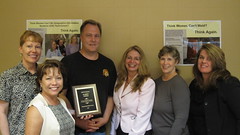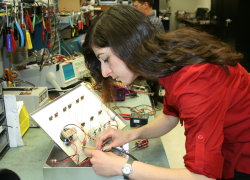State of the Union: Career Pathways for Working Families
I listened carefully to President Obama’s State of the Union Address last month and was pleased to hear him say, “Still, in this economy, a high school diploma no longer guarantees a good job. That’s why I urge the Senate to follow the House and pass a bill that will revitalize our community colleges, which are a career pathway to the children of so many working families.”
IWITTS’ work focuses on ensuring that working women are part of the science and technology landscape with an emphasis on technician-level careers. Sometimes we are asked, “Why focus on careers at the technician level? Every girl and woman should have the opportunity to go to four-year colleges.”
True, however, if we only introduce women and girls to engineering and science careers that require a bachelor’s degree or graduate education, we will have missed the opportunity to impact the majority of women and girls who come from working families and who attend community colleges, not four-year universities.
IWITTS strives to bridge the gender gap in technology for these women and girls in particular because 1) they have made the fewest inroads in the science and technology workforce and 2) they are among those most in need of better jobs.
Women and girls of working families deserve entrée to the jobs of the future – green jobs, biotechnology, medical information technology and construction – and I am so glad that President Obama has focused attention on our community colleges and the career pathways they provide to all students.
What do you think? Should we focus primarily on professional occupations for women and girls in Science, Engineering, Math & Technology (STEM) or should we focus in all areas including at the technician level?

Our series of 7 posters feature real women working in trades & tech. Use them in classrooms, counseling offices and hallways to make women think twice about their career options.

 The bright spot on the economic recovery horizon is green jobs. Community colleges are partnering with Workforce Investment Boards to provide education/training to prepare the workforce for this new sector. But is it so new?
The bright spot on the economic recovery horizon is green jobs. Community colleges are partnering with Workforce Investment Boards to provide education/training to prepare the workforce for this new sector. But is it so new?
 Instructors, administrators and counselors from the eight California community colleges involved in the CalWomenTech Project came together a couple of weeks ago to share their successes recruiting and retaining women to targeted technology programs and to problem solve as a group to overcome key challenges they are encountering. One of the issues is the current economic situation in California, which seemed relevant to our audience across the country, and so I wanted to share some of the great solutions our colleges came up with:
Instructors, administrators and counselors from the eight California community colleges involved in the CalWomenTech Project came together a couple of weeks ago to share their successes recruiting and retaining women to targeted technology programs and to problem solve as a group to overcome key challenges they are encountering. One of the issues is the current economic situation in California, which seemed relevant to our audience across the country, and so I wanted to share some of the great solutions our colleges came up with: See Wechie’s Comment of 8/21: There seems to be hundreds of separate initiatives to encourage girls to study computer science but there remains an image problem. How can we get an industry wide campaign going to improve the image of computing?
See Wechie’s Comment of 8/21: There seems to be hundreds of separate initiatives to encourage girls to study computer science but there remains an image problem. How can we get an industry wide campaign going to improve the image of computing? Julia Child actually gives us some guidance on what to do when as a woman you are blocked by another woman. (See my earlier post of 8/20). Essentially the same thing you would do if you were blocked by a man. 1) She uses politically savvy – by referencing her ally in power (the ambassador); 2) she persists by insisting she be given the test and by asking to be given it again when it is designed for her to fail; 3) she over prepares and studies long, long hours – determined to pass; 4) she does not take it personally.
Julia Child actually gives us some guidance on what to do when as a woman you are blocked by another woman. (See my earlier post of 8/20). Essentially the same thing you would do if you were blocked by a man. 1) She uses politically savvy – by referencing her ally in power (the ambassador); 2) she persists by insisting she be given the test and by asking to be given it again when it is designed for her to fail; 3) she over prepares and studies long, long hours – determined to pass; 4) she does not take it personally. A number of you asked me for more information about the training video that I mentioned in my Julie/Julia post. Here’s a description:
A number of you asked me for more information about the training video that I mentioned in my Julie/Julia post. Here’s a description: Recruiting 101: Have you visited the career links section of
Recruiting 101: Have you visited the career links section of  Recruiting 101: The key to recruiting women and girls in a field in which they are under-represented is female role models. You already know their numbers are small, so where do you find these women? IWITTS did a survey in 2005 and found that among educators word of mouth was the leading strategy (86%), followed by connecting with women on the street (66%). Respondents also found doing a newspaper story on their program effective! In addition, I’d recommend putting flyers up in your community saying you are looking for female role models in specific occupations.
Recruiting 101: The key to recruiting women and girls in a field in which they are under-represented is female role models. You already know their numbers are small, so where do you find these women? IWITTS did a survey in 2005 and found that among educators word of mouth was the leading strategy (86%), followed by connecting with women on the street (66%). Respondents also found doing a newspaper story on their program effective! In addition, I’d recommend putting flyers up in your community saying you are looking for female role models in specific occupations. I had the good fortune of seeing the movie Julie and Julia this past weekend and I loved it, as did the rest of the audience! Everyone clapped after many of the scenes—something which rarely happens in the movies. The movie is based on the true stories of the famous, American-French chef Julia Child (played by Meryl Streep) and a New York writer named Julie who decides to cook all of Julia’s recipes in a year and to blog about it daily.
I had the good fortune of seeing the movie Julie and Julia this past weekend and I loved it, as did the rest of the audience! Everyone clapped after many of the scenes—something which rarely happens in the movies. The movie is based on the true stories of the famous, American-French chef Julia Child (played by Meryl Streep) and a New York writer named Julie who decides to cook all of Julia’s recipes in a year and to blog about it daily.




Recent Comments